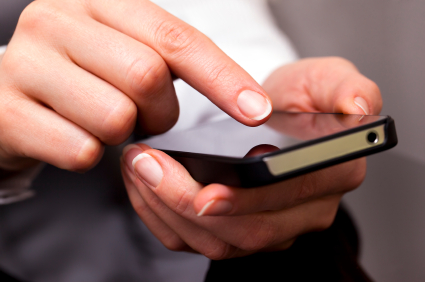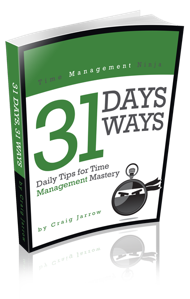
How do you deal with the email flood?
Most of us receive too much email. Our inboxes are overflowing.
Are you bailing as fast as it is building up?
Or are you guilty of opening that email and then putting it back in your inbox…?
Looking And Touching
How often do you look at your email?
Better yet, how often do you take a quick look and then leave the new emails in your inbox?
Eek! Don’t do that.
That’s like stuffing your physical mail back in the mailbox. (Do you do that, too?)
When you look at your email and then leave it in your inbox…
You are not only creating more work for yourself,
But, you are multiplying your email load.
Think about how many times you end up touching the same email.
Don’t Do It Twice
Don’t open your email and then put it back in your inbox.
Instead, take immediate action with it.
Here are 7 tips to ensure that you don’t touch email more than once:
- Dedicate Email Time – Instead of randomly checking your email throughout the day, schedule specific times to check it. Dedicate those times to actually processing email, rather than poking around but not dealing with anything.
- Answer It Immediately – Instead of hesitating, respond to emails immediately. Keep it short and sweet. I like responding via my iPhone and iPad because it prevents long responses. Keep in mind, you should only be doing this during your dedicated email times. Otherwise, you will end up in a game of email Ping-Pong with some enthusiastic emailer.
- Add It To Your Todo List – You inbox should not be your todo list. Many people leave emails in their inbox because they “haven’t done them yet.” Instead, add that todo to your list and then file/delete the email.
- Don’t Look At It – We have become addicted to looking at our email. Do you really need to check it three times during lunch on your phone? Remove email accounts from your smartphone. You won’t miss them as much as you think. And definitely turn off push email. You don’t need to know the instant an email arrives. (Refer to #1)
- Delete it – Many emails can be deleted immediately. And I am not referring to spam. Unless they contain reference material, most emails can be immediately deleted or archived. Ctrl-D (Windows) and Command-Delete (Mac) should be your best friends.
- Prevent It – One of the best ways to avoid email is to prevent it before it happens. Don’t subscribe to unnecessary email lists. Get a good spam filter. Unsubscribe from commercial lists. (I use an even simpler method… with Sanebox’s Blackhole feature I get rid of junk mail forever with one click.)
- File It – Answer it, delete it, or finally…. File It. If you are done with an email, but think you made need to refer to it later, then file it. Some people spend more time filing their email than reading it, setting up dozens of complicated folders. I minimize filing options and instead use powerful search tools to instantly locate past emails. No need to go digging through archive folders.
Multiplying Your Email
Chances are, you already get enough email. Don’t add to the situation.
When you touch the same email multiple times you are multiplying your email.
When you deal with your email, deal with it and be done with it.
Share Your Tips: What are your best email processing tips? Please share in the comments below.
 I am the author of Time Management Ninja and help individuals and companies reclaim their time to be more productive. As well, I am the author of the book
I am the author of Time Management Ninja and help individuals and companies reclaim their time to be more productive. As well, I am the author of the book 

I’ve been following a similar process for some time myself. I have 3 scheduled email time slots a day. (I sometimes do ad-hoc reading but only when I really have nothing else immediate to do.)
Everything gets either: deleted, archived, filed in Evernote, added to Wunderlist or responded to. (In order of frequency!)
I wish more people would adopt a similar policy – the number of people who send an email, expecting an immediate response is unfathomable.
Ady
Great, Ady! Sounds like you have quite the email flow down!
I’m so guilty of this and it does add more work in the long run.
Imagine if you had to read every email you got… 3-4 times. 😛
Eek.
I know, you would freak if you saw my inbox!
Fine post. Thanks Craig.
I’ve gotten much better at not looking because of necessity. I also enjoyed testing a product called Sanebox that helps separate important from non-important emails (as priority inbox was supposed to do).
Brad… loving @Sanebox:twitter here too! Watch for a full review.
My favorite feature has to be… the Black Hole. 🙂
So much this. What a great article. +1 for Sanebox.
Thx, Jeremy!
BTW, watch for a review of Sanebox very soon. 🙂
I recently set up a “rule” to send e-mail from senders with my employer’s domain name to a separate “read now” inbox that I check more frequently, and try to limit the times I mess with the rest of it. So far it’s really helped reduce some of that e-mail stress.
Really awesome post Craig. The best I’ve seen on the topic! And thanks for the sanebox mention!
Thanks, Dmitri!
Will connect again soon… looking to do a full review of Sanebox. 😉
What a great post Craig! While I enjoy working from a clean inbox, utilizing the methods you recommend above; I am still very guilty of stalking my own email. I need to get better about systematically checking it.
I laughed at the reference of putting mail back in the mailbox. I know many who will mark the email as “unread” as a reminder of a to-do. Are these same people re-sealing the electric bill in hopes it will get paid from the mailbox? 🙂
Yes! It always amazes me when I watch people mark something as “unread.” 🙂
Errr… yep! Clearly you’ve been looking in my inbox. 😛
As usual Craig, you hit on things that hurt me most. Damn email costs me at least 2-3 hours aggregated. I must check out this @Sanebox:twitter
The last time I tried something to save time with email, I ended up with thousands of unchecked emails in my Inbox.
Ash, let me know how you like it. I have been using it for a short time and love it.
It will make your nervous at first, as it is moving emails into folders… out of sight.
But, once you get it dialed in… it keeps the unimportant messages out of your way.
🙂
Sure Craig, Will check it out and let you know. I am sure it’s going to help big time.
Great article , Graig. I’ll also have a look to @Sanebox:twitter . The “Don’t look at it “tip is the most difficult tip I have to achieve in my company: I have 3 time slots during which I check (and processs) my emails. But very often, people (well, mostly the sales guys which are always “on fire”) sent me emails and come to me a quarter later “Hey, man, could we discuss about my latest email ?”. My response is always the same: “why sent you me an email while you pertinently know you’ll come here a few minutes to discuss about ?”
In our “instant answer world”, people have difficulties to understand that some have not their eyes always focused on the inbox view.
Who has had experience trying to shift an entire workplace to batch process email? I love the idea of this my challenge is institutional culture change
Matt… good topic.
Changing yourself is one thing. Changing an organization’s behavior is something much bigger.
I have seen many a company roll-out new “tools” or “processes” only to watch no one use them.
Your topic “institutional culture change” is a good one. Not sure I have a quick answer, but maybe a good topic… in the near future. 🙂
First time on the site. This is really good. Do you have any tricks for putting email on a to do list? I use Mac mail and haven’t figured out how to easily drag or notate email as a to do other than flagging it and leaving it in my inbox. I’d love to clear them out!
Thanks
Mark
I know many people might not find this kosher, but I pretty regularly check my inbox. I deal with urgent things. I delete the junk and just file away the stuff that I don’t need to take action on. Those things that I do need to eventually act on I move to a holding cell folder that I batch process once a day or so.
You say “add it to your to do list” – my biggest frustration is figuring out how to get my emails in to a todo list or task app – what do you feel is the best process?
Try using todoist.com for your task management. They have support for mail clients, including gmail, that makes adding emails to your TODO lists pretty easy. They have many other nice features as well.
Create separate folders and rules to direct CC: and DList mail there. Check these only infrequently as the mail isn’t actually addressed directly to you. This cut volume of real mail by 40-50%. Also only respond if a response is truly required, and don’t forget that the phone is your friend – unless you can complete an email exchange in <5 emails, use the phone.